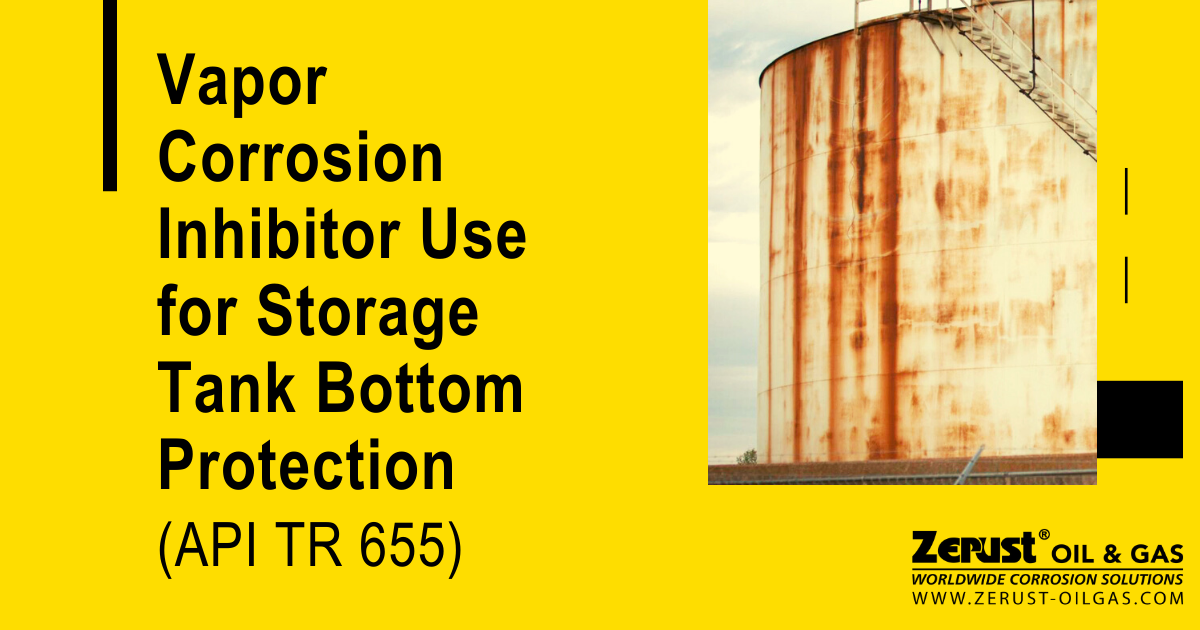Vapor Corrosion Inhibitor Use for Storage Tank Bottom Protection (API TR 655)

Vapor Corrosion Inhibitor Use for Storage Tank Bottom Protection (API TR 655)
The American Petroleum Institute (API) released Technical Report API TR 655, which discusses using Vapor Corrosion Inhibitors (VCIs) to protect aboveground storage tank (AST) bottoms from soil-side corrosion. The report synthesizes a large body of client field results and shows VCI performance comparable to traditional cathodic protection (CP) in applicable scenarios.
Want a quick summary of TR 655 instead? Read our overview post here.
Vapor Corrosion Inhibitors (VCIs) - Overview
Within API TR 655, the focus is the amine-carboxylate group of VCI chemistries for soil-side protection of carbon steel bottoms. VCI molecules volatilize, migrate through enclosed airspace, and adsorb on metal surfaces to inhibit corrosion (via barrier films, scavenging, pH buffering, etc.). When the source is depleted, VCIs can be replenished to maintain protection.
How VCIs Complement CP
The existing CP practice is outlined in API RP 651, which also notes CP limitations and cases where CP is not feasible. TR 655 shows how VCIs fill those gaps and how VCI + CP can be used synergistically.
Terminals & Common Foundation Types
Many terminal tanks lack active CP and use simple foundations (bituminous or oiled sand over soil, gravel, or concrete). These can dry or admit water/oxygen/contaminants over time, driving corrosion on the tank bottom. Section 4 of TR 655 discusses foundation types and VCI application methods suited to each.
Addressing Specific Limitations
For concrete ring wall + compacted sand designs, annular plate corrosion at the chime is a well-known issue. API 651 offers limited guidance here. Section 5 of TR 655 describes introducing VCIs as sand additives and outlines several installation methods.
Where product level changes flex the bottom plate and create gaps between steel and pad, CP current may not reach those voids. Section 7 of TR 655 covers VCI + CP combined techniques to mitigate corrosion and meet regulatory expectations.
Further reading: How to determine whether VCIs, CP, or both should be used to protect ASTs.
ROI & Monitoring
Extending bottom life maximizes ROI toward the 20-year out-of-service cycle in API 653. TR 655 Section 6 discusses monitoring with steel coupons and ER probes and provides guidance for VCI replenishment based on measured conditions.
Regulatory Note
"Breakout tanks" under US DOT PHMSA require CP. While PHMSA evaluation of VCI use continues, owners can deploy VCIs (alone or with CP) to improve protection where CP is impractical or insufficient—consistent with TR 655 guidance.
Conclusion
VCIs give owners another proven tool—usable with most foundation types, with or without CP—to mitigate soil-side corrosion and extend tank bottom life. As API and AMPP publish guidance, VCI adoption continues to grow across AST applications worldwide.
Purchase API TR 655
Get the report from the API Publications Store. For help applying VCIs to your tanks, contact us.

